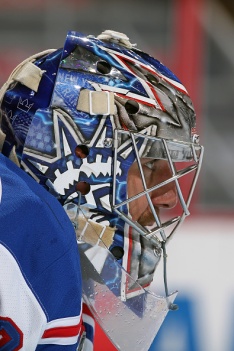
The mask, an iconic piece of equipment within the sport. Designed to protect and install fear in the eyes of your opponent, it’s hard to imagine getting onto the ice without one. But it wasn’t always this way. We all know that there was a time when players did not wear masks, but what happened to change this? What has changed about the mask? and is it fully protective?
The history
The first time a mask was seen on a goaltender was in 1927 by Elizabeth Graham (Queen’s University, Ontario) to protect her teeth from being damaged. At this point, the mask used was a metal fencing one, unregulated and unable for use in a match.
Clint Benedict (Montreal Maroons) became the first player in the sport to wear a mask during a regulation game. This was to protect his recently broken nose. His mask at this point was a leather one, normally used in American Football as a ‘nose-guard’. After the match, Benedict never wore a mask again for the remainder of his career.
 The beginning. The first player to wear a mask full-time came in 1959 after being struck in the face with a puck. Jacques Plante was previously not allowed to wear a mask during games over worries that his visibility would be affected. However, after the hit Plante’s made an ultimatum, being able to wear the mask on the ice, or he walks. The mask used was made of fiberglass and became a commonality within the sport. The final player to play without a mask was Andy Brown (Pittsburgh Penguins) who retired in 1974.
The beginning. The first player to wear a mask full-time came in 1959 after being struck in the face with a puck. Jacques Plante was previously not allowed to wear a mask during games over worries that his visibility would be affected. However, after the hit Plante’s made an ultimatum, being able to wear the mask on the ice, or he walks. The mask used was made of fiberglass and became a commonality within the sport. The final player to play without a mask was Andy Brown (Pittsburgh Penguins) who retired in 1974.
Safety first
From the introduction and regulation of masks in hockey, the sport has taken big strides to combat injury. But first, the injury. To get to where we are there have been severe injuries. Most prominent and memorable of all is Clint Malarchuk. 
Malarchuk suffered a fatal injury after two players crashed into the goal and severed his carotid artery and jugular vein. At this point, goalies used the fiberglass/cage mask that many had criticized for its visibility issues.
However, after seeing Malarchuks injury there was a push in regulation to combat such injuries from happening again. To do so the NHL introduced the full fiberglass helmets that we see being worn in the game today.
The main difference between the full fiberglass/birdcage helmet and the type Malarchuk used in his time is the introduction of the neck visor. This protects players from getting hit by pucks or blades in the neck. With this advancement, goalies are not only protected more but are also able to stretch themselves into new positions to make better saves without risk of major injury.
The fashion
With the full fiberglass masks, there is now more head being covered, which apparently means more decoration.
Mask decorations had always been visible within the sport, dating back to Boston Bruins goaltender Gerry Cheevers (picture at top). The scars that Cheevers had painted onto his mask were meant to represent the scars he would have if he didn’t wear his mask. Similar to the look of Sawchuk who was well-known in the sport for his various scars and bruises from being hit by pucks without a mask.
The decoration a player wears on his mask creates a link between the player and the team. Lundqvist pictured left, famous for his remarkable career with the New York Rangers is famous for his statue of liberty mask. The mask is now not only a symbol of safety within the sport but also one of connectivity to a team as well as one of personal character and history.
Thank you for reading. For more follow us on Twitter @STPUnews
-Theodore

